
26 minute read
STEEL CONSTRUCTION NEWS
Steel Construction News 1/2021
ECCS NEWS
ECCS member news
ECCS welcomes a new member: PIKS – Polish Chamber of Steelwork
The Polish Chamber of Steelworks is a self-regulatory organization established in June 1996 by 115 founding members associating, in diferent periods, 125–150 companies of various size, ownership status and activity profle, including:
– Steel structure manufacturers and assembly companies, – Companies cooperating in production and distribution of steel, aluminium systems and lightweight casing, technology and fasteners and welding materials as well as deliveries and services with respect to corrosion protection and fre safety, – Scientifc, research, design and specialist entities.
For more information see www.piks.com.pl/en
European Steel Design Awards 2021: Call for entries is open!
The submission of national projects for the 2021 European Steel Design Awards 2021 has been launched. The ESDA Ceremony which will be held in Paris in September. This years call addresses as usually all kinds of steel structures but fosters also a special award for bridges. To participate, see your national steel construction association or send your request to eccs@steelconstruct.com.
Projects must be submitted by 30th April 2021.
ECCS NEWS
ECCS R&D activities
RFCS projects
FAILNOMORE – mitigation of the risk if progressive collapse in steel and composite frames under exceptional events
The main aim of this project is to produce a set of practical and user-friendly design guidelines for mitigating the risk of progressive collapse of steel and composite structures subjected to exceptional events such as impact and explosions. This will be based on recent research projects and available normative documents in order to propose a common design methodology to be implemented in the European practice. The main dissemination will be through a design manual including worked examples, which will be drafted in various national languages, as well as a series of training workshops in 11 European countries.
The project started on 1 July 2020 and is coordinated by University of Liège.
List of National Constructional Steel Days in 2021
Czech Republic: Czech Steel Conference 4 November 2021, www.caok.cz
Denmark: Danish National Steel Day 11 November 2021, www.steelday.dk
Norway: Norwegian Steel Day 11 November 2021, www.norskstaldag.no
Switzerland: Swiss National Steelday+ 7 October 2021, Bern, www.steelday.ch
Turkey: Turkish Constructional Steel Day 24 November 2021
Eurosteel – 9th European Conference on Steel and Composite Structures Shefeld 1–3 September 2021, eurosteel2020.com
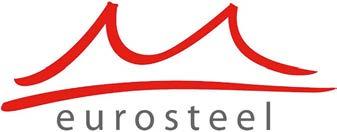
More information at www.steelconstruct. com/EUProjects/Failnomore
FREEDAM + Valorisation of knowledge for FREE from DAMage steel connections
The project FREEDAM (RFSR-CT-201500022), regarded the design and testing of innovative connections equipped with friction dampers able to withstand without any damage the seismic events. FREEDAM+ aims at the valorization, the dissemination and the extension of the results to a wide audience.
The dissemination will turn around preparation of a series of informative documents concerning the connections equipped with friction dampers in 13 languages (English, Spanish, French, German, Italian, Dutch, Portuguese, Czech, Bulgarian, Romanian, Greek, Turkish and Slovenian).
The project started on 1st July 2020 and is coordinated by the University of Salerno.
More information at www.steelconstruct. com/EUProjects/Freedam
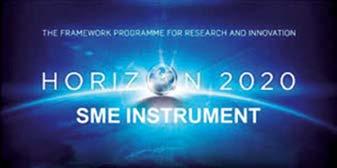
HORIZON 2020 projects
PULVERCOAT

PulverCoat is a new generation of advanced thermosetting powder coatings that polymerize at lower temperatures (110–130°C) with a reaction mechanism 10 times faster than common powder coatings, enabling curing to take place in just 3–5 minutes.
Due to COVID-19, the project ending on 30 September was extended for a period of 6 months.
More information at www.pulvercoat.eu
NEW SKIN – Innovation Eco-system to Accelerate the Industrial Uptake of Advanced Surface Nano-Technologies
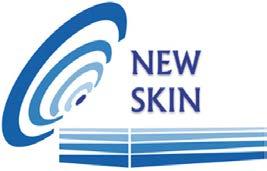
The NewSkin project aims to create an “Open Innovation Test Bed (OITB)”, this is a new concept launched by the Commission in order to further support the SMEs sector. An OITB is a legal entity, enterprise-like, which will provide the European Innovation Ecosystem (the sector, the industries and companies) with the necessary technologies, resources and services to uptake a set of game changing, efcient and cost- efective innovative processes to manufacture nano-enabled industrial and consumer products as well as the necessary testing capabilities to demonstrate nano-enhanced goods features. The project is coordinated by ECCS.
The NewSkin innovative manufacturing up-scaling and testing facilities will provide the sector with the necessary tools to create and validate system prototype demonstration in operational environment, new technologies to meet the challenges of key European Industries such as Steel, Ceramics, Transport, Water Treatment and the General industry.
NewSkin will impact the Steel Construction Industry in four diferent areas:
– Newskin will transfer the Steel Industry novel nano-technologies that will allow to reach and demonstrate new levels of performance and durability (ice, fouling, corrosion, wear and fre resistance) under combined stresses in harsh environments and extreme industrial conditions. – Advanced continuous processes will be also transferred to the Steel Industry for the production of functional surfaces on steel cladding, envelopes, structures and components. – NewSkin will transfer the Innovation
Ecosystem high performance nano-coatings and structures for steel drilling, machining and cutting machine tooling and components increasing processes efciency, reducing costs and environmental impacts as well as avoiding the lines shutdowns and major equipment failures. – Highly efcient water treatment technologies to recycle and reuse of cutting fuids and other steelwork related efuents.
ECCS is leading the NewSkin Consortium in the identifcation of challenges and opportunities within the Steel Industry through the ECCS Technical Committees and the ECCS network. In parallel, ECCS has launched the high-performance coatings and technologies engagement activities to promote the uptake of novel technologies by the Steel Construction Industry achieving new levels of performance in steel protection and the deployment of novel functionalities.
The NewSkin project has been presented to the ECCS Technical Management board on 18 November 2020 and to ECCS National association members on 19 November 2020. It has also been presented to the TCs dealing with fre protection, surface protection, stability, composite structures, sustainability and energy supporting structures.
More information at www.steelconstruct.com/EUProjects/
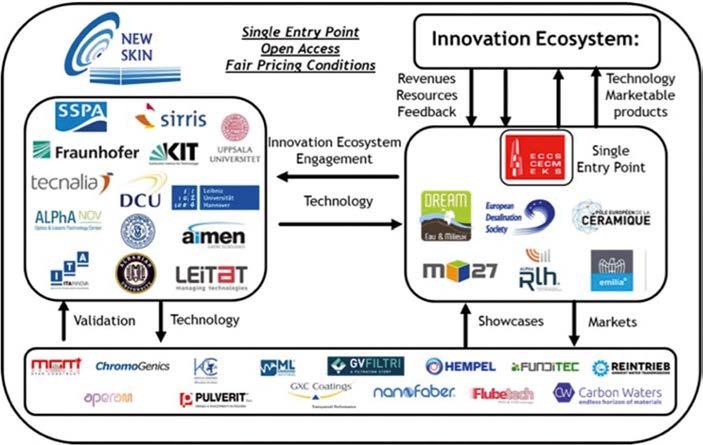
News from Europe
Construction in national recovery plans: The built environment must be a priority for next generation
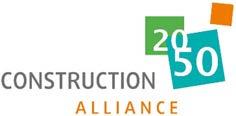
On 3rd December, the Construction 2050 Alliance brought together experts from all over Europe, including representatives from the European Commission, the European Parliament, and national governments. They discussed the important role that construction may play as the severely hit European economy recovers from the COVID-19 pandemic. The Alliance’s key message is that the built environment must be a key priority in all national Recovery plans and in the new EU funding initiatives.
As in our fght against climate change, for which the construction ecosystem plays a key role, the built environment provides solutions to mitigate the impact of the pandemic. Indeed, while it was estimated that on average European citizens spend more than 90% of their time indoors, this has signifcantly increased as confnements and curfews have become the new norm. Living in safe, healthy, properly ventilated and energy efcient buildings is thus crucial for EU citizens, the economy, and the planet.
It is for the reasons highlighted here above that, the members of the Construction 2050 Alliance held a high-level discussion on the role that the built environment should play in the post-COVID-19 recovery, more specifcally, its weight in future decisions on European funding in response to the pandemic. This frst public event of the Construction 2050 Alliance allowed for open and transparent exchanges between Member States representatives, Members of the European Parliament (MEPs), high-level Commission ofcials, as well as European construction experts. Whilst Member States presented their plans for the built environment in their respective national strategies under the new recovery instrument, “Next Generation EU”, the European Commission confrmed that construction may be prioritized in the national Recovery Plans as it can play a key role in the recovery and resilience of the EU’s economy.
However, this must be requested by Member States that have full ownership of their national Recovery Plans and should be the result of a consultation exercise with national stakeholders.
On the same line, MEPs Iskra Mihaylova (Bulgaria, RE) and Pernille Weiss (Denmark, EPP) suggested that national debates feed each other through an exchange of best practices on efective policy measures. The representatives of the Alliance stressed that investments in the renovation and modernization of the European buildings and infrastructure will deliver positive results in terms of health, comfort, adaptability and environmental impacts. Such investments ofer key opportunities for a built environment that would be more resilient, safer, more comfortable, more cost-efcient and sustainable.
Therefore, the 47 EU associations that form the Alliance call together for the built environment to be a key priority in all national recovery plans and in the new EU funding initiatives.
New Circular Economy Action Plan

1. What is the expected impact of
COVID-19 on the new CEAP?
It will be an imperative step in Europe’s journey to become climate neutral by around mid-century. To enable this change, we urgently need a functioning market for quality secondary raw materials and circular products.
The Commission’s action plan has a real potential to help achieve these markets. It can lead to more circular product designs, better consumer awareness of wasteful behaviour, higher demand for circular and low carbon products, as well as new technologies and improved waste management systems. It can also focus on better implementation in the member states and create similar policy frameworks/standards across the G20. European businesses are fully engaged as is shown by the 200 circular business examples on www.circulary.eu
For example, companies are working on new business models that aim to create value for consumers by extending the lifetime of products. COVID19 is providing an unprecedented shock to the global system that will result in several negative GDP quarters, with the EU expected to experience a GDP contraction of 7.4–7.9% in 2020 (Commission 2020 Spring
Economic Forecast / BusinessEurope 2020 Spring Economic Outlook), while more severe scenarios putting this fgure at around –12% in 2020 (ECB).
Though the EU’s policy response has also been unprecedented, the recovery will likely only be gradual. Overall, Europe could face an €850bn shortfall in private sector investment in the next couple of years (2020
SEF), of which an estimated €25bn loss is in total R&D investment. This will undoubtedly have an impact on the fnancial capacity of countries and companies to invest in a circular and sustainable economy. 2. What view on lifecycle of products?
Should it just look at the recyclability of products, or also other elements (e.g. longevity)?
The lifecycle of a product should be based on more than simply its recyclability, as recycling alone will not be enough to create a fully functioning circular economy in Europe. All signifcant stages of the product’s lifecycle need to be considered. This can include longevity as a means to promote waste prevention, which features at the top of the waste hierarchy. In many cases, a proper selection of materials and protecting them with additives (such as in the case of plastics) provide a sensible “no-regret” contribution to circularity. That said, it would be important to defne longevity carefully.
Source: BusinessEurope, position paper, new circular economy action plan: https://www.businesseurope.eu/
News from the world
GLOBE – Global Consensus on Sustainability in the Built Environment
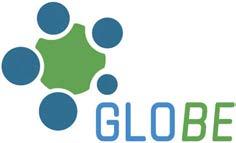
“Nothing less than a transformative and united worldwide efort from all stakeholders of the construction sector is required for human society to be successful in sustainable development, and in the mitigation of the disastrous consequences of climate change at global and local scales”. This is the central message of the GLOBE Consensus, which has been recently stipulated by an international group of experts, mandated by seven of the leading professional associations in the domain of construction engineering1.
GLOBE stands for Global Consensus on Sustainability in the Built Environment and it highlights the global challenges associated with the built environment as a main contributor to climate change.
The GLOBE Consensus is targeted to societal decision makers and professionals in the construction industry and calls for a coordinated and joint efort to counter global climate change. The objective is to make players in the construction area aware of their enormous responsibility; GLOBE puts sustainability in the construction sector and the built environment on the global agenda – at the same level of importance as safety and durability. The consensus document further addresses facilitators and suggests clear actions, which must be implemented immediately.
“Sustainability and mitigation of climate change is a global challenge – that must be addressed in a global collaborative and focused efort – and this is what the GLOBE Consensus is really all about”, according to Prof. Michael Havbro Faber, President of the Joint Committee on Structural Safety, Aalborg University, Denmark.
“With increasing urbanization and construction demand and more and more limited resources, the construction industry and the profession of civil engineers become the most relevant drivers for positive socio-economical and environmental developments and more sustainable processes. Nevertheless, most actors are not even aware of their individual role and responsibility in this challenge. Therefore, the GLOBE consensus is a milestone, which directly addresses all actors in the entire built environment and encourages them to become change drivers towards a better future perspective”, Dr. Wolfram Schmidt (BAM) states, who studies local material solutions for global challenges.
“Global warming is the major challenge facing humanity. Everything must be done to lower emissions, and the built environments represents a major part of embodied CO2”, Prof. Karen Scrivener (EPFL) states, who is a leading expert in sustainable cement and production technology.
Judith Hardy, who is Secretary General of RILEM and wholeheartedly dedicated a lot of efort into the successful fnalization of GLOBE states “I am pleased to support the GLOBE action and to provide through RILEM the service to spread the word amongst scientists and practitioners”
The expert group strongly proposes that a globally composed task force is established and mandated to support supranational and national policy makers with respect to sustainable development in the construction sector and the built environment.
More detailed information on the GLOBE Consensus may be found on the GLOBE homepage where the GLOBE Consensus may be found in English, Chinese, Spanish, German and Kiswahili and more language translations are in process: www.rilem.net
ECCS NEWS
Publications
139 – From Assessment to Best Practice – A collection of historical fatigue damage cases in steel and composite bridges, TC6 Fatigue and Fracture.
140 – Background information on fatigue design rules – statistical evaluation, TC6 Fatigue and Fracture. 142 – European Recommendations for the Design, Detailing and Application of Fastenings for Sandwich Panels, TC7 TWg 7.9 Sandwich Panels and related Structures, together with CIB. 401 – Diseño de Estructuras de Acero (Spanish version of the Design Manual for Steel Structures).
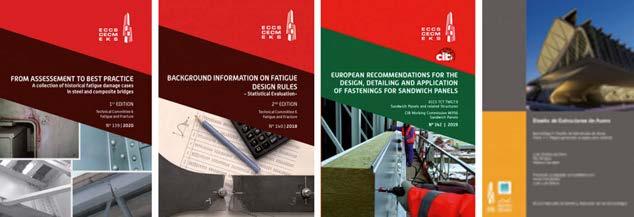
Building logbook state of play
Report 2 of the study on the development of a European Union framework for buildings’ digital logbook
Over the lifespan of buildings, data is routinely collected by multiple stakeholders for various reasons as many decisions rely on data availability. However, the lack of a common approach and structure among stakeholders which would make this wealth of information widely available, organised and easily accessible, makes this data often unusable as it gets discarded, forgotten or it is not compatible with other stakeholders’ systems. The lack of an overarching structure shared across the built environment leads to information asymmetry, lack of transparency and higher risk for investment and decisions. Tools for information management applied to buildings have the potential to enable better decision making throughout the building lifespan: management of technical and function aspects, safety, conservation of economic value, certifcation, improved energy and environmental performances, etc. Organised and shared data that can be re-used would not only reduce uncertainty but also time and cost needed for recollecting missing information. In a more simplistic concept, building logbooks are a repository developed for the management of buildings information. Overtime, due to the complexity of buildings and the number of stakeholders involved, the idea of building logbooks has developed in diferent ways, resulting in the creation of an array of tools and requirements across Europe and worldwide for collecting and using buildings’ data. To be able to inform future decisions and set a direction that will support the widespread use of digital building logbooks across Europe, it is important to understand what is already available, in particular what works and what doesn’t, in the existing (and past) building logbooks.
Building logbook state of play – Publications Ofce of the EU (europa.eu):
https://op.europa.eu/en/publicationdetail/-/publication/58580f81-06b7-11 eb-a511-01aa75ed71a1
NEWS
The International Colloquium on Stability and Ductility of Steel Structures – SDSS 2022 will be held at University of Aveiro, Portugal, on 14-16 September 2022. It follows the successful series of SDSS colloquia, which started in 1972, in Paris, and had the last fve editions held in Budapest, Hungary (2002), Lisbon, Portugal (2006), Rio de Janeiro, Brazil (2010), Timisoara, Romania (2016) and Prague, Czech Republic (2019).
The series of International Colloquia on Stability and Ductility of Steel Structures aims at providing a forum for discussion and dissemination, by researchers and designers, of the most recent advances in theoretical, numerical and experimental research in the feld of stability and ductility of steel and composite steel and concrete structures. Special emphasis is always given to new concepts and procedures concerning the analysis and design of steel structures and to the background, development and application of rules and recommendations either appearing in recently published codes and specifcations or about to be included in their upcoming versions. The SDSS 2022 participants will be able to become familiar with the most recent achievements in the advancement of knowledge and application in the above felds, share the latest trends and developments and exchange ideas on current and future research needs.
The SDSS series has been supported by the Structural Stability Research Council (SSRC) and by the European Convention for Constructional Steelwork (ECCS). As in previous colloquia, the Structural Stability Technical Committee (TC8) from ECCS will organize parallel special sessions. Publisher Ernst & Sohn and its Steel Construction journal are media partner of SDSS 2022. Steel Construction journal calls again for a best paper award and will publish selected papers afterwards.
International Colloquium on Stability and Ductility of Steel Structures 2022 14 – 16 September 2022 University of Aveiro, Portugal www.ua.pt/pt/sdss2022
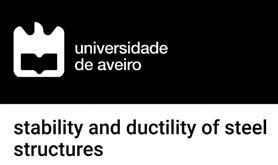
NEWS
The second Steel Construction Online Live Seminar Structural member stability in the second generation of Eurocode 3 with Prof. Markus Knobloch (Ruhr-Univ. Bochum), Prof. Ulrike Kuhlmann (Stuttgart Univ.) and Prof. Andreas Taras (ETH Zurich) as well as Anna-Lena Bours and Fabian Jörg takes place online on 26 March 2021, 10.00 to 12.00 a.m. CET. The OLS gives an overview of the developments of the structural member verifcation in prEN 1993-1-1:2020 “Eurocode 3: Design of steel structures – part 1-1: General rules and rules for buildings”, of the second generation of Eurocodes. Many improvements to design rules have been established with respect to structural analysis, resistance of cross-sections and stability of members. The OLS focuses on member stability design rules and deals with the basis for the calibration of partial factors, the introduction of more economic design rules for semi-compact sections, methods for structural analysis in relation to the appropriate member stability design rules, new design rules for lateral torsional buckling plus other developments and innovations. The upcoming most relevant changes to member buckling design rules are thus illustrated.
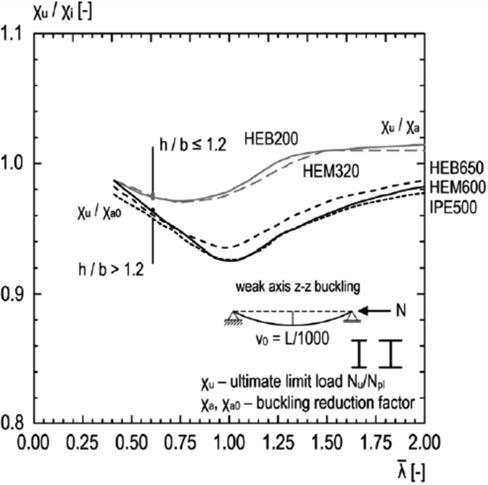
Results of resistance calculations for different rolled sections in grade S460 The keynote is based on a two part paper by Knobloch, M.; Bureau, A.; Kuhlmann, U.; da Silva, L. S.; Snijder, H. H.; Taras, A.; Bours, A.-L.; Jörg, F. Structural member stability verifcation in the new Part 1-1 of the second generation of Eurocode 3, Part 1: Evolution of Eurocodes, background to partial factors, cross-section classifcation and structural analysis (DOI: 10.1002/stco.202000016), Part 2: Member buckling design rules and further innovations (DOI: 10.1002/ stco.202000027), which have been published in Steel Construction 13 (2020), issues 2 and 3.
STCO OLS #2 Structural member stability in the second generation of Eurocode 3
The Keynote on structural member stability in Eurocode 3 addresses the following topics in detail:
1. General background to the development of – the second generation of Structural
Eurocodes – prEN 1993-1-1:2020 2. Enhancing “ease of use” for structural analysis (methods of analysis for ultimate limit state design checks) 3. Improvements to – classifcation of cross-sections – design rules for semi-compact sections – imperfections – design rules for lateral torsional buckling 4. Extension and innovation of – the scope of stability verifcations – circular and elliptical hollow sections – buckling curves for heavy sections, for angles and for hot rolled I- and H- sections in grade S460 – local load introduction without stifeners Prof. Markus Knobloch, Prof. Ulrike Kuhlmann, Prof. Andreas Taras et al.
26 March 2021 10.00 – 12.00 a.m. CET
Info und registration: www.ernst-und-sohn.de/stco-seminar
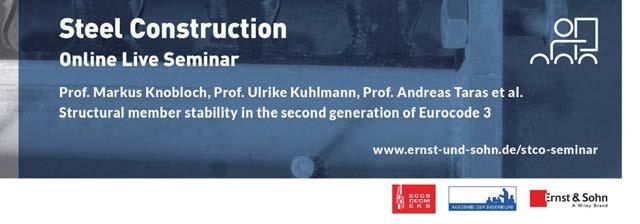
NEWS
New European Bauhaus: European Commission launches design phase
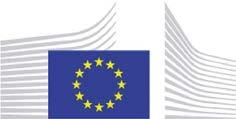
The European Commission has launched the design phase of the New European Bauhaus initiative, which is an environmental, economic and cultural project, aiming to combine design, sustainability, accessibility, afordability and investment in order to help deliver the European Green Deal. The core values of the New European Bauhaus are thus sustainability, aesthetics and inclusiveness. The goal of the design phase is to use a co-creation process to shape the concept by exploring ideas, identifying the most urgent needs and challenges, and to connect interested parties. As one element of the design phase, this spring, the Commission will launch, the frst edition of the New European Bauhaus prize.
This design phase will lead to the opening of calls for proposals in autumn this year to bring to life New European Bauhaus ideas in at least fve places in EU Member States, through the use of EU funds at national and regional level. Further information can be found at https://europa.eu/new-european-bauhaus
List of reviewers who have completed at least one review for Steel Construction in 2020. The editors would like to thank all reviewers, also on behalf of the authors.
Mohammad Al-Emrani Vincente Alero Hamidreza Babaali Eduardo de Miranda Batista Daniel Bitar Tiago Braga Abecasis Alain Bureau Martin Classen Luís Simões da Silva Buick Davison Jean-Francois Demonceau Pampa Dey Florea Dinu Imke Engelhardt Markus Feldmann Cai Gaocuang Leroy Gardner Max Gündel Jerome Hajjar Gregory James Hancock Stephen James Hicks Jörg Hildebrand Jakob Laigaard Jensen Markus Knobloch Rafaele Landolfo Luiz Alberto Araújo de Seixas Leal Martin Leitner Gerhard Lener Guo-Qiang Li Richard Liew Luciano Lima Frithjof Marten Pierre-Olivier Martin Federico Mazzolani Enrique Mirambell Christoph Odenbreit Kiyoshi Ono Matthias Oppe Kim Rasmussen Carlos Rebelo Paul Richards Manuel L. Romero Pavel Ryjácˇek Amir Saedi Daryan Daniel Schäfer Gang Shi Geralt Siebert Hubertus Snijder Léopold Sokol Hans-Albert Städler Andreas Taras Detlef Ulbrich Viorel Ungureanu Brian Uy Ioannis Vayas Michael Vormwald František Wald Nesrin Yardimci Kan Zhou
Events
Place and date Event Details
Online 26 March 2021
Guimarães, Portugal 12–14 May 2021
Poznan´, Poland 16–18 June 2021
Stromberg, Germany 26–30 July 2021
Shefeld, UK 1–3 September 2021
Madrid, Spain 8–10 September 2021
Stuttgart, Germany 5–7 October 2021
Bern, Switzerland 7 October 2021
Karlsruhe, Germany 26–29 April 2022
Aveiro, Portugal 14–16 September 2022 Steel Construction – Online Live Seminar Prof. Knobloch, Prof. Kuhlmann and Prof. Taras: Structural member stability in the second generation of Eurocode 3 www.ernst-und-sohn.de/en/steelconstruction-online-live-seminar
18th International Probabilistic Workshop (IPW2020) ipw2020.com
14th International Conference on Metal Structures icms2021.put.poznan.pl
9th International Conference on Composite Construction in Steel and Concrete (CCIX)
Eurosteel 2021 www.compositeconstructionix.com/ ccix/index.html.en
www.eurosteel2020.com
Footbridge
parts2clean
Steelday+
PaintExpo
International Colloquium on Stability and Ductility of Steel Structures 2022 www.footbridge2020.com
www.parts2clean.de
steelday.ch
www.paintexpo.com
www.ua.pt/pt/sdss2022
26 March 2021 10.00–12.00 a.m. CET
With a series of Online Live Seminars (OLS) ECCS Steel Construction (STCO) journal presents international keynote speakers with up to date topics. Partner of the STCO OLS series is the European Convention for Constructional Steelworks (ECCS). The online lecture takes up to 1.5 hours. Following the speakers are available for questions and answers.
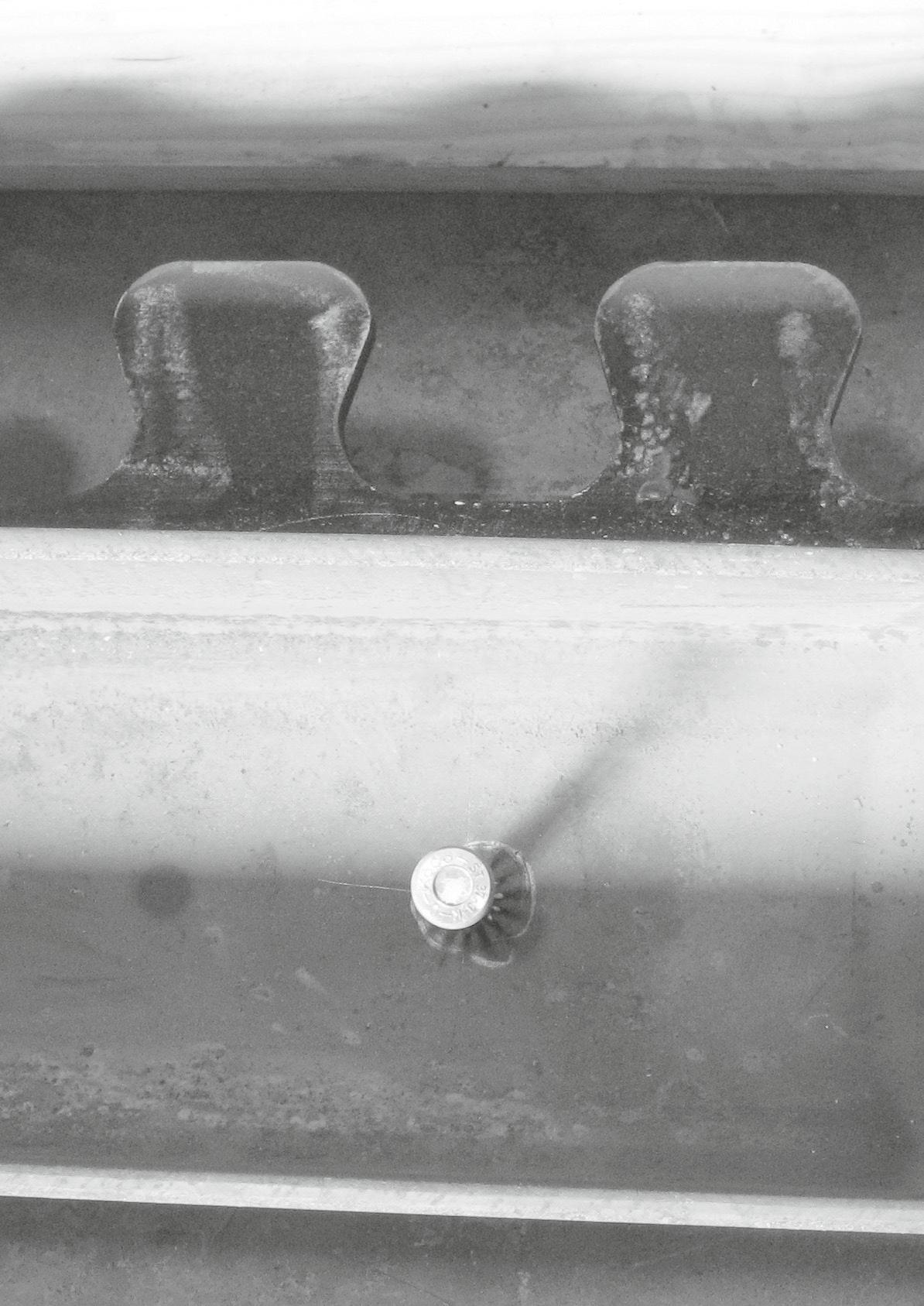
STCO OLS #2 will be given by Prof. Markus Knobloch, Ruhr-University Bochum, Prof. Ulrike Kuhlmann, Stuttgart University and Prof. Andreas Taras, ETH Zurich – supported by Anna-Lena Bours and Fabian Jörg – with a keynote Structural member stability in the second generation of Eurocode 3 at 26 March 2021 10.00 to 12.00 a.m. CET. The keynote is based on a two part paper by Knobloch, M.; Bureau, A.; Kuhlmann, U.; da Silva, L. S.; Snijder, H. H.; Taras, A.; Bours, A.-L.; Jörg, F. Structural member stability verification in the new Part 1-1 of the second generation of Eurocode 3, Part 1: Evolution of Eurocodes, background to partial factors, cross-section classification and structural analysis (DOI 10.1002/ stco.202000016),
Registration
www.ernst-und-sohn.de/stco-seminar
Fees
39 €* (regular) 29 €* (ECCS/national associations members)
www.ernst-und-sohn.de/stco-seminar
* Excl. VAT. The General Terms and Conditions of the Akademie der Ingenieure apply.
The articles published in the journal are protected by copyright. All rights are reserved, particularly those of translation into foreign languages. No part of this journal may be reproduced in any form whatsoever without the written consent of the publisher. Brand-names or trademarks published in the journal are to be considered as protected under the terms of trademark protection legislation, even if they are not individually identifed as such.
Manuscripts are to be sent to the editorial staf or http://mc.manuscriptcentral.com/stco.
If required, ofprints or run-ons can be made of single articles. Requests should be sent to the publisher.
Current prices The journal “Steel Construction – Design and Research” comprises four issues per year. In addition to “Steel Construction – Design and Research print”, the PDF version “Steel Construction – Design and Research online” is available on subscription through the “Wiley Online Library” online service.
Prices print print + online single issue Institutional 655 € 819 € 174 €
Members of the ECCS – European Convention for Constructional Steelwork receive the journal Steel Construction as part of their membership.
Prices exclusive VAT and inclusive postage. Errors and omissions excepted. Subject to change without notice. Student prices, bulk prices and prices in other currencies on request.
Prices are valid from 1st September 2020 until 31st August 2021.
Personal subscriptions may not be sold to libraries nor used as library copies.
A subscription lasts for one year. It can be terminated in writing at any time with a period of notice of three months to the end of the subscription year. Otherwise, the subscription extends for a further year without written notifcation.
“Steel Construction – Design and Research”, ISSN 1867-0520, is published quarterly. US mailing agent: SPP, PO Box 437, Emigsville, PA 17318. Periodicals postage paid at Emigsville PA.
Postmaster: Send all address changes to “Steel Construction – Design and Research”, John Wiley & Sons Inc., C/O The Sheridan Press, PO Box 465, Hanover, PA 17331.
Publisher Wilhelm Ernst & Sohn Verlag fur Architektur und technische Wissenschaften GmbH & Co. KG Rotherstrasse 21, 10245 Berlin, Germany Phone +49 30 47031-200, Fax +49 30 47031-270 info@ernst-und-sohn.de www.ernst-und-sohn.de
Journal for ECCS members The ECCS – European Convention for Constructional Steelwork and Ernst & Sohn have agreed that from 2010 onwards Steel Construction is the ofcial journal for ECCS members. www.steelconstruct.com
Editor-in-chief Bernhard Hauke, Ernst & Sohn, ECCS Phone +49 160 97858589 bhauke@wiley.com
Project Editor Giulia Fumagalli Phone +49 30 47031-269, Fax -410 giulia.fumagalli@wiley.com
Editorial Board Véronique Dehan, European Convention Constructional Steelworks Prof. Markus Feldmann, ECCS, RWTH Aachen University Luís A. P. Simões da Silva, University of Coimbra Olivier Vassart, ArcelorMittal Scientifc Board Frans Bijlaard, Technical University Delft Dinar Camotim, Instituto Superior Técnico Lisbon S. L. Chan, The Hong Kong Polytechnic University Paulo Cruz, University of Minho Jean François Demonceau, ECCS, University of Liege Dan Dubina, Polytechnic University Timisoara László Dunai, Budapest University Morgan Dundu, University of Johannesburg Markus Feldmann, ECCS, RWTH Aachen University Dan Frangopol, Lehigh University Leroy Gardner, Imperial College Jerome Hajjar, North Eastern University Jean-Pierre Jaspart, University of Liege Ulrike Kuhlmann, University of Stuttgart Jörg Lange, ECCS, Technical University Darmstadt Rafaele Landolfo, ECCS, University of Naples Guo-Qiang Li, Tongji University Richard Liew, National University of Singapore Enrique Mirambell, Polytechnic University of Catalunya Kim Rassmunsen, University of Sydney John Michael Rotter, The University of Edinburgh Peter Schaumann, ECCS, Leibniz University Hannover Bert Snijder, ECCS, Technical University Eindhoven Luís A. P. Simões da Silva, University of Coimbra Kunitomo Sugiura, Kyoto University Andreas Taras, ETH Zürich Thomas Ummenhofer, ECCS, Karlsruhe Institute of Technology Viorel Ungureanu, ECCS, Polytechnic University of Timisoara Ioannis Vayas, National Technical University Athens Milan Veljkovic, ECCS, Technical University Delft Pedro Vellasco, Rio de Janeiro State University Paulo Vila Real, ECCS, University de Aveiro František Wald, Czech Technical University Prague Riccardo Zandonini, University of Trento
Industrial Board Alexander Britner, ECCS, KIT Center Steel Timber Masonry Véronique Dehan, European Convention Constructional Steelworks Mladen Lukic, ECCS, CTICM Koen Michielsen, Infosteel Belgium/Luxembourg Kjetil Myhre, ECCS, Norwegian Steel Association Till Vallée, Fraunhofer IFAM Olivier Vassart, ArcelorMittal
Advertising sales manager Dominique Riedel, Ernst & Sohn Phone +49 30 47031-252, Fax -230 dominique.riedel@wiley.com
Services for customers and readers Wiley-VCH Customer Service for Ernst & Sohn Boschstrasse 12, D-69469 Weinheim Tel.: +49 (0)800 1800 536 (Germany) Tel.: +44 (0)1865476721 (outside Germany) Fax: +49 (0)6201 606184 cs-germany@wiley.com Quicklink: www.wileycustomerhelp.com
Layout and typesetting TypoDesign Hecker GmbH, Leimen
Printing Westermann DRUCK | pva, Zwickau
© 2021 Ernst & Sohn Verlag für Architektur und technische Wissenschaften GmbH & Co. KG, Berlin
Inserts in this issue:
Verlag Ernst und Sohn, 10245 Berlin

Steel-concrete-steel composite (SCSC) plates are used for single-track, short-span railway bridges in transverse direction. The described simple framework engineering model including springs considers cyclic loading and inelastic slip. (Palotás, B. et al.)
Preview 2/21
Dheeraj Karki, Harry Far
State of the art on composite cold-formed steel fooring systems
Hassan Al-Karawi, Mohammad Al-Emrani
The effciency of HFMI-treatment and TIG-remelting in fatigue life extension of existing welded structures
Peter Schaumann, Manuela Böhm, Karsten Schürmann
Improvements in the fatigue design of support structures for offshore wind turbines
Bálint Palotás, Patrik Takács, Josef Fink
Simulation of a SCSC plate with a spring framework model including the effects of inelastic slip
Damaso Dominguez, Gary S. Prinz
Cyclic behavior of laterally skewed special moment frame connections having composite concrete slabs
(subject to change without notice)
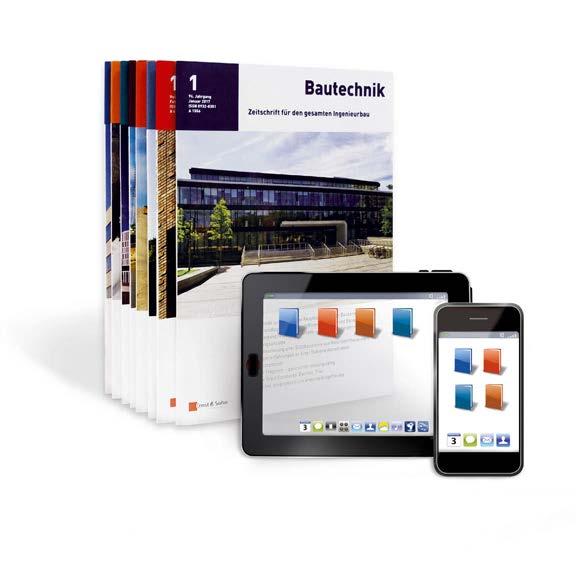
Technical articles online available
all Ernst & Sohn journals over 31,000 technical articles going back to 1967 easy research PDF download





